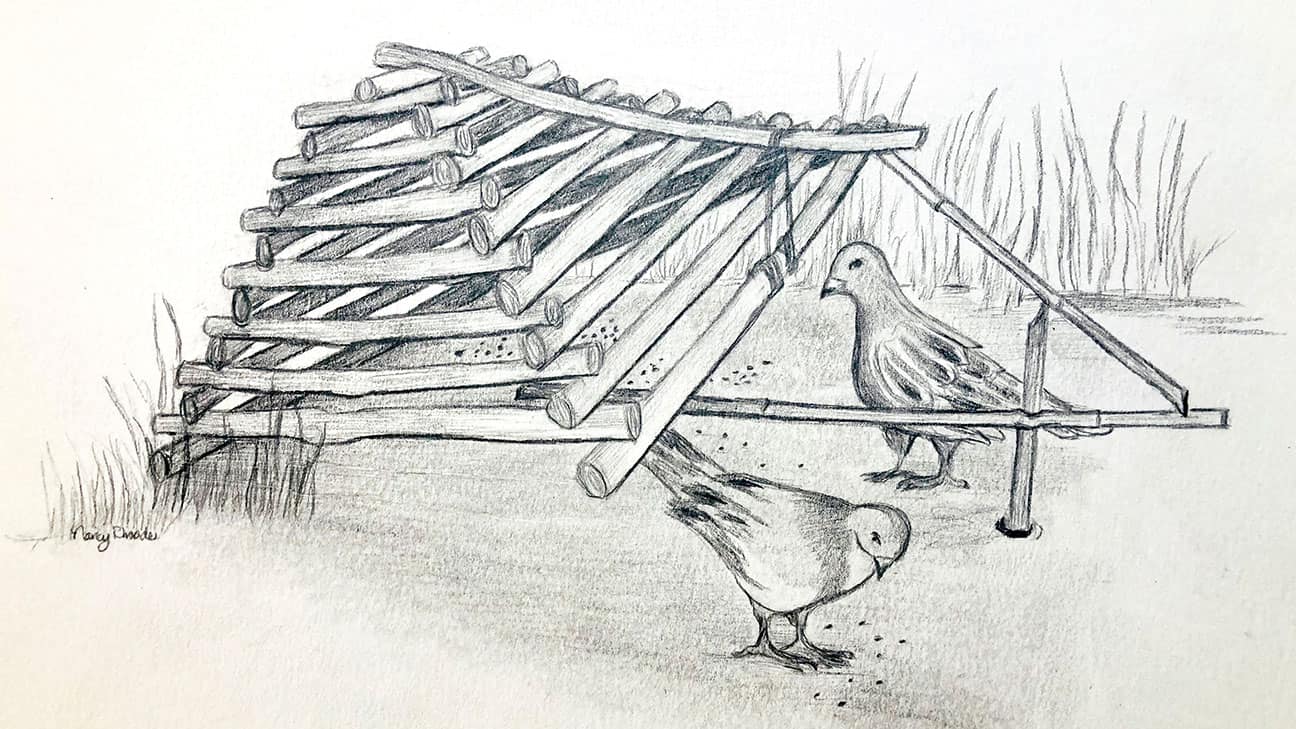
Drawing of a Choctaw bird trap by Choctaw artist Nancy Rhoades.
Hushi Isht Vlbi — traditional Choctaw bird trap
Iti FabvssaPublished September 1, 2020This month, Dr. Ian Thompson shares a special opportunity that he was given to learn about traditional Choctaw bird traps from an elder: Hushi Isht Vlbi – “bird trap” is an entry in the Byington Choctaw Language Dictionary that had always intrigued me. Although giving a little bit different name, Chief Allen Wright mentioned them in his Choctaw Definer too. That both of these Choctaw language sources have a term for “bird trap” seems to indicate that these traps were once important in Choctaw life. It should come as no surprise that our ancestors would have trapped birds for food and feathers, but I often wondered exactly what these traps were like. In years of learning about Choctaw history and Indigenous culture, I had never come across so much as another mention of them.
That unexpectedly changed in the spring of 2020, when Tom Colvin, a good friend and knowledgeable elder stayed in our home through part of the Coronavirus shutdown. After he casually mentioned a Choctaw bird trap, I learned that Mr. Colvin had been taught how to make them by Sanville Johnson of the Bayou Lacomb Choctaw community who had often used them. Mr. Colvin and his older brother grew up making and using these traps to catch birds that his mother then cooked for supper. Mr. Colvin found that other Choctaw communities in Louisiana and Mississippi had used these traps too. Sixty years ago, they were also commonly used by non-Choctaw communities in Louisiana, and many traced their knowledge about them to back to Choctaw people. Mr. Colvin had never mentioned these traditional bird traps to me in our conversations because he had thought that they were just common knowledge for Choctaw people!
This style of traditional Choctaw bird trap consists of a basket, set up as a deadfall on a “Figure 4” trigger. The basket is made from straight twigs about a finger’s width in diameter. The twigs are cut to length in groups of two. The first two are cut around 16 inches long. The next two about 3/4 of an inch shorter, and so-on until the last pair of twigs is about 3 inches long. A short string is tied around the middle of each of the two longest twigs. These two twigs are placed on the ground parallel to each other, and then a notch is cut into both sticks near both ends. The next longest pair of sticks is whittled flat on one side near both ends. These sticks are laid perpendicularly over the first pair to make a square shape, with the flat areas resting in the notches that were cut into the bottom sticks, kind of like a log cabin. Construction proceeds with flattening, notching, and layering progressively shorter pairs of sticks to create a pyramid shape. At the apex of the pyramid, is one three inch long stick, laid parallel to the two sticks at the bottom of the pyramid that have the strings tied to them. A notch is cut into the middle of the 3-inch stick on its top side to accommodate a flexible, but stiff stick laid perpendicularly over it. The ends of this stick are bent downwards with a bit of force and tied to the bottom two sticks via the short strings. Tension holds the basket part of the trap together. The trigger mechanism, carved from three straight, narrow twigs, is shown in the diagram. The construction of this little trap is pretty ingenious. With no nails, glue, and only very limited binding material required, it can easily be made in the field with a small knife or even stone tools.
The trap is set by leaning the basket up on one end and precariously supporting the top side of on the vertical part of the “Figure 4′ trigger. Food that will attract the type of bird that you want to trap is placed on the ground leading to the trap. A larger amount is placed inside the trap, and some more is placed onto the end of the horizontal stick in the triggering mechanism. When a bird pecks or bumps the end of it, the “Figure 4” falls apart and the trap is sprung. The bird that triggered the trap, and any others that may have been under the basket when it fell, are caught live.
Today, laws protect robins, blue jays, and other small birds, but our ancestors used them for food. They could be cleaned and roasted on the fire in camp or used as flavoring in dishes like ashela, a cornmeal dish that often includes wild fowl. From sources that know, some of these little birds are fine eating.

One of the beauties of this bird trap is that, rather than requiring someone to sit around with a string all day waiting for a bird to enter the trap, it operates on its own and doesn’t need constant supervision. One person could have easily set a dozen of these traps and gone on to do other activities, coming back to check the traps once a day. Of course, Choctaws are not the only people to have figured out such a clever and efficient means of trapping small birds. Although they usually differ in some of the details, other Southeastern Tribes and people as far away as Europe traditionally made traps that look and function very much like what has just been described. Choctaw men made a second, and different kind of trap for catching turkeys. Mr. Colvin was taught how to make these as well and has graciously shared the knowledge. Stay tuned for a future article.
To date, the Historic Preservation Department hasn’t run across anyone in Oklahoma who grew up using traditional traps. If you did, we’d love to hear from you at 580-642-7981 or [email protected].

